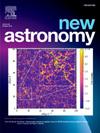Analysis and simulations of binary black hole merger spins — The question of spin-axis tossing at black hole formation
IF 2.1
4区 物理与天体物理
Q2 ASTRONOMY & ASTROPHYSICS
引用次数: 0
Abstract
The origin of binary black hole (BH) mergers remains a topic of active debate, with effective spins () measured by the LIGO-Virgo-KAGRA (LVK) Collaboration providing crucial insights. In this study, our objective is to investigate the empirical distribution (and constrain individual spin components) of binary BH mergers and compare them with extensive simulations, assuming that they originate purely from isolated binaries or a mixture of formation channels. We explore scenarios using BH kicks with and without the effect of spin-axis tossing during BH formation. We employ simple yet robust Monte Carlo simulations of the final core collapse forming the second-born BH, using minimal assumptions to ensure transparency and reproducibility. The synthetic distribution is compared to the empirical data from LVK science runs O1–O3 using functional data analysis, kernel density estimations, and three different statistical tests, accounting for data uncertainties. We find strong indications for spin-axis tossing during BH formation if LVK sources are dominated by the isolated binary channel. Simulations with spin-axis tossing achieve high p-values (up to 0.882) using Kolmogorov–Smirnov, Cramer-von Mises, and Anderson–Darling tests, while without tossing, all p-values drop below 0.001 for isolated binaries. A statistically acceptable solution without tossing, however, emerges if of detected binary BH mergers result from dynamical interactions causing random BH spin directions. Finally, for an isolated binary origin, we find a preference for mass reversal in of the progenitor binaries. Predictions from this study can be tested with LVK O4+O5 data as well as the 3G detectors, Einstein Telescope and Cosmic Explorer, enabling improved constraints on formation channel ratios and the critical question of BH spin-axis tossing.
双黑洞合并自旋的分析与模拟——黑洞形成时的自旋轴抛射问题
双黑洞(BH)合并的起源仍然是一个活跃的争论话题,LIGO-Virgo-KAGRA (LVK)合作项目测量的有效自旋(χeff)提供了重要的见解。在这项研究中,我们的目标是研究双星黑洞合并的经验χeff分布(并约束单个自旋分量),并将它们与广泛的模拟进行比较,假设它们纯粹来自孤立的双星或形成通道的混合物。我们探索了在黑洞形成过程中使用有或没有自旋轴抛射影响的黑洞踢球的情况。我们采用简单而稳健的蒙特卡罗模拟,最终核心坍缩形成第二个黑洞,使用最小的假设,以确保透明度和可重复性。综合χeff分布与LVK科学运行O1-O3的经验数据进行了比较,使用功能数据分析,核密度估计和三种不同的统计检验,考虑了数据的不确定性。我们发现,如果LVK源由孤立的二元通道主导,则在黑洞形成过程中有明显的自旋轴抖动迹象。使用Kolmogorov-Smirnov, Cramer-von Mises和Anderson-Darling测试,具有自旋轴投掷的模拟获得了高p值(高达0.882),而没有投掷,孤立二进制的所有p值都低于0.001。然而,如果探测到的双黑洞合并中有~ 72±8%是由导致随机黑洞自旋方向的动态相互作用引起的,那么就出现了一个统计上可接受的解决方案。最后,对于孤立的双星起源,我们发现在约30%的双星祖先中有质量反转的倾向。这项研究的预测可以用LVK O4+O5数据以及3G探测器、爱因斯坦望远镜和宇宙探测器进行测试,从而改善对形成通道比率的限制,并解决黑洞自旋轴摆动的关键问题。
本文章由计算机程序翻译,如有差异,请以英文原文为准。
求助全文
约1分钟内获得全文
求助全文
来源期刊

New Astronomy
地学天文-天文与天体物理
CiteScore
4.00
自引率
10.00%
发文量
109
审稿时长
13.6 weeks
期刊介绍:
New Astronomy publishes articles in all fields of astronomy and astrophysics, with a particular focus on computational astronomy: mathematical and astronomy techniques and methodology, simulations, modelling and numerical results and computational techniques in instrumentation.
New Astronomy includes full length research articles and review articles. The journal covers solar, stellar, galactic and extragalactic astronomy and astrophysics. It reports on original research in all wavelength bands, ranging from radio to gamma-ray.
 求助内容:
求助内容: 应助结果提醒方式:
应助结果提醒方式:


